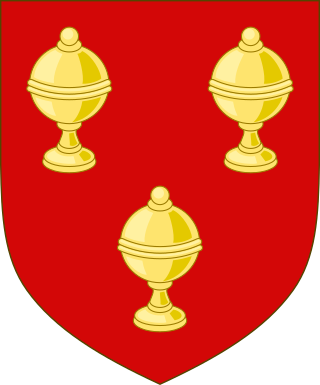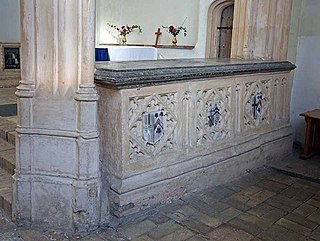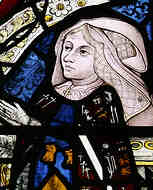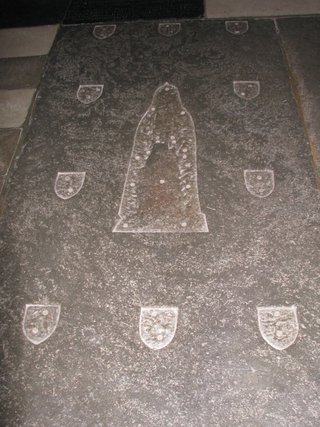A Francisation of traditional English "Bullen" coming from the French name Boulogne, Boleyn is the surname of a noble English family particularly prominent in the Tudor period. People with this surname include:

Thomas Boleyn, Earl of Wiltshire, 1st Earl of Ormond, 1st Viscount RochfordKGKB, of Hever Castle in Kent, was an English diplomat and politician who was the father of Anne Boleyn, the second wife of King Henry VIII, and was thus the maternal grandfather of Queen Elizabeth I. By Henry VIII he was made a knight of the Garter in 1523 and was elevated to the peerage as Viscount Rochford in 1525 and in 1529 was further ennobled as Earl of Wiltshire and Earl of Ormond.
Jane Boleyn, Viscountess Rochford was an English noblewoman. Her husband, George Boleyn, Viscount Rochford, was the brother of Anne Boleyn, the second wife of King Henry VIII, and a cousin to King Henry VIII's fifth wife Catherine Howard, making Jane a cousin-in-law. Jane had been a member of the household of Henry's first wife, Catherine of Aragon. It is possible that she played a role in the verdicts against, and subsequent executions of, her husband and Anne Boleyn. She was later a lady-in-waiting to Henry's third and fourth wives, and then to his fifth wife, Catherine Howard, with whom she was executed.

George Boleyn, Viscount Rochford was an English courtier and nobleman who played a prominent role in the politics of the early 1530s as the brother of Anne Boleyn, second wife of King Henry VIII. George was the maternal uncle of Queen Elizabeth I, although he died long before his niece ascended the throne. Following his father's promotion in the peerage in 1529 to Earl of Wiltshire and Earl of Ormond, he adopted his father's junior title Viscount Rochford as a courtesy title. He was accused of incest with his sister Anne during the period of her trial for high treason, as a result of which both were executed.
Elizabeth Boleyn, Countess of Wiltshire was an English noblewoman, noted for being the mother of Anne Boleyn and as such the maternal grandmother of Elizabeth I of England. The eldest daughter of Thomas Howard, 2nd Duke of Norfolk and his first wife Elizabeth Tilney, she married Thomas Boleyn sometime in the later 15th century. Elizabeth became Viscountess Rochford in 1525 when her husband was elevated to the peerage, subsequently becoming Countess of Ormond in 1527 and Countess of Wiltshire in 1529.

Elizabeth Seymour was a younger daughter of Sir John Seymour of Wulfhall, Wiltshire and Margery Wentworth. Elizabeth and her sister Jane served in the household of Anne Boleyn, the second wife of Henry VIII. The Seymours rose to prominence after the king's attention turned to Jane. In May 1536, Anne Boleyn was accused of treason and adultery, and subsequently executed. On 30 May 1536, eleven days after Anne's execution, Henry VIII and Jane were married. Elizabeth was not included in her sister's household during her brief reign, although she would serve two of Henry VIII's later wives, Anne of Cleves and Catherine Howard. Jane died 24 October 1537, twelve days after giving birth to a healthy son, Edward VI.
Viscount Rochford is a title that has been created twice in the Peerage of England.

Sir Francis Weston KB was a gentleman of the Privy Chamber at the court of King Henry VIII of England. He became a friend of the king but was later accused of high treason and adultery with Anne Boleyn, the king's second wife. Weston was condemned to death, together with George Boleyn, Viscount Rochford, Henry Norris, William Brereton and Mark Smeaton. They were all executed on 17 May 1536, two days before Anne Boleyn suffered a similar fate.

Catherine Carey, after her marriage Catherine Knollys and later known as both Lady Knollys and Dame Catherine Knollys,, was chief Lady of the Bedchamber to Queen Elizabeth I, who was her first cousin.
Events from the 1530s in England.
Sir William Boleyn, KB of Blickling Hall in Norfolk and Hever Castle in Kent, was a wealthy and powerful landowner who served as Sheriff of Kent in 1489 and as Sheriff of Norfolk and Suffolk in 1500. He was the father of Thomas Boleyn, 1st Earl of Wiltshire, whose daughter was Queen Anne Boleyn, the second wife of King Henry VIII.

Lady Margaret Boleyn was an Irish noblewoman, the daughter and co-heiress of Thomas Butler, 7th Earl of Ormond. She married Sir William Boleyn and through her eldest son Sir Thomas Boleyn, was the paternal grandmother of Anne Boleyn, second wife of King Henry VIII of England, and great-grandmother of Anne and Henry's daughter, Elizabeth I of England.
Sir William Stafford, of Chebsey, in Staffordshire was an Essex landowner and the second husband of Mary Boleyn, who was the sister of Anne Boleyn, Queen of England. Mary was one-time mistress of King Henry VIII of England.
Anne, Lady Shelton was a sister of Thomas Boleyn, 1st Earl of Wiltshire, and one of the aunts of his daughter, Queen Anne Boleyn, the second wife of King Henry VIII.

Sir John Shelton of Shelton in Norfolk, England, was a courtier to King Henry VIII. Through his marriage to Anne Boleyn, a sister and co-heiress of Thomas Boleyn, 1st Earl of Wiltshire of Blickling Hall in Norfolk, he became an uncle of Queen Anne Boleyn, the second wife of King Henry VIII. He was appointed comptroller of the joint household of Princesses Mary and Elizabeth, the King's daughters, and together with his wife was Governor to the King's children.

Mary Boleyn, also known as Lady Mary, was the sister of English queen consort Anne Boleyn, whose family enjoyed considerable influence during the reign of King Henry VIII.

Elizabeth Tilney, Countess of Surrey was an English heiress who became the first wife of Thomas Howard, 2nd Duke of Norfolk. She served successively as a lady-in-waiting to two Queen consorts, namely Elizabeth Woodville, wife of King Edward IV, and later as Lady of the Bedchamber to that Queen's daughter, Elizabeth of York, the wife of King Henry VII. She stood as joint godmother to Princess Margaret Tudor at her baptism.
Elizabeth, Lady Boleyn was a lady-in-waiting at the court of Henry VIII of England. Through her marriage to Sir James Boleyn, she was the aunt of Henry VIII's second wife, Anne Boleyn. The two were not close, and Elizabeth Boleyn acted as her niece's gaoler when Queen Anne was arrested on charges of adultery, incest and conspiracy to kill the King.
Sir Edward Bayntun, of Bromham, Wiltshire, was a gentleman at the court of Henry VIII of England. He was vice-chamberlain to Anne Boleyn, the King's second wife, and was the brother-in-law of Queen Catherine Howard, Henry VIII's fifth wife.
Mary Scrope was an English courtier. She was the granddaughter of Henry Scrope, 4th Baron Scrope of Bolton, and the sister of Elizabeth Scrope, wife of John de Vere, 13th Earl of Oxford, and Margaret Scrope, wife of Edmund de la Pole, 3rd Duke of Suffolk. She is said to have been in the service at court of King Henry VIII's first four wives. As the wife of Sir William Kingston, Constable of the Tower of London, she was in attendance on Anne Boleyn during the Queen's brief imprisonment in the Tower in May 1536, and both she and her husband were among those who walked with the Queen to the scaffold. By her first husband, Edward Jerningham, she was the mother of Sir Henry Jerningham, whose support helped to place Queen Mary I on the throne of England in 1553, and who became one of Queen Mary's most favoured courtiers.

Lady Anne Boleyn was an English noblewoman, noted for being the great grandmother of Anne Boleyn and therefore the maternal great-great grandmother of Elizabeth I of England. She was the only child of Thomas Hoo, Baron Hoo and Hastings, and his first wife Elizabeth Wychingham. She married Sir Geoffrey Boleyn in c.1445.